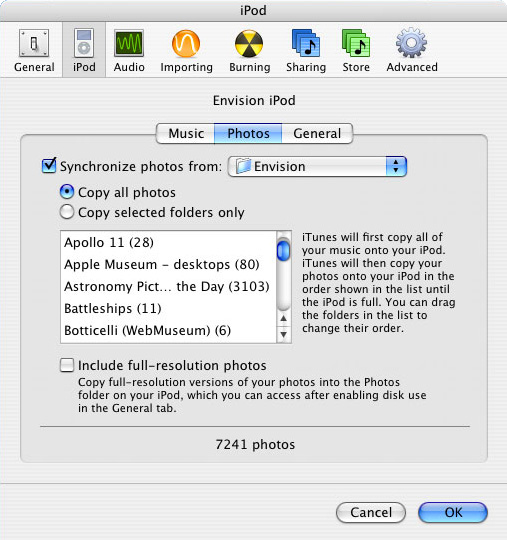
Envision
the new way to experience the Web
User's Guide - Saving & Using Images

Envision
the new way to experience the Web
User's Guide - Saving & Using Images
This chapter describes how to save the images retrieved by Envision, and how to use them for purposes other than Web shows, such as screen saver, desktop image or Envision Everywhere.
Envision allows you to copy individual images to your drive.
You can have Envision store a show's images for use in your Macintosh's built-in screen saver. Before you use this option for the first time, you must do a little setup. It's done in two steps: choose a folder for Envision to store images in, and configure the OS X Screen Saver to get images from that folder.
Within the folder that you specify for Envision, a subfolder is created for each show. Images displayed in that show are copied to the appropriate subfolder. The OS X Screen Saver finds images in each subfolder. Once Envision knows where to store images, and the Screen Saver knows to look in that folder for images, you can enable and disable the saving of images for use in the Screen Saver by choosing menu item File->Images->Save to Screen Saver. When you make a new show or open a saved show, Save to Screen Saver is off and must be manually turned on again.
Envision can save images for use as your Mac's desktop picture. You can do this for a single image, or for all images in a show.
A third way to use Envision images for your desktop is to use the images that Envision has saved for use as the Screen Saver.
* Note that you must specify the folder of a specific show, not the overall folder used by Envision. The OS X Desktop mechanism looks for images only in the folder you specify, and not in subfolders.
Support for Envision Everywhere
The Web's images, as displayed by Envision, are so amazing that in many cases you may want to move those images even further beyond the confines of your traditional Web browser's windows. You may actually want to move those images off your Macintosh entirely. Envision Everywhere is a set of technologies and recommendations that allow images retrieved by Envision to be displayed not only on your Macintosh, but on other devices as well, such as the iPod photo, flat-panel TVs, and digital picture frames. The Envision Everywhere Web site has all the details.
Most external display devices using Envision images will get those images from your Macintosh. Envision's Save to Pictures Folder option (under Images in the File menu) will cause Envision to copy all images it displays to a folder named Envision within the Pictures folder that resides in your Home folder. Images from a given show will go in a subfolder named for that show, allowing you to keep images from different shows separate. Images stored in the Envision folder can then be accessed for display by different devices. The details of exactly how a device accesses those images depend on the device.
As a specific Envision Everywhere example, here's how Envision's images can be displayed on an iPod photo. Photos (as well as music) are automatically synchronized between your Mac and iPod photo using the iTunes application. After connecting your iPod to your Mac, run iTunes, choose Preferences from the File menu, click the iPod button and choose Photos. The following dialog appears.

Figure 1. iPod image synchronization
By selecting the Photos tab, and then checking Synchronize photos from, and specifying the Envision folder, you can transfer the images from one or more shows to the iPod. Additionally, whenever you re-run iTunes with your iPod connected, iTunes will resynchronize any new images from the shows with your iPod.
 Forward to Making a Good Show
Forward to Making a Good Show
 Back to Authoring for iEnvision
Back to Authoring for iEnvision
 Back to Table of Contents
Back to Table of Contents